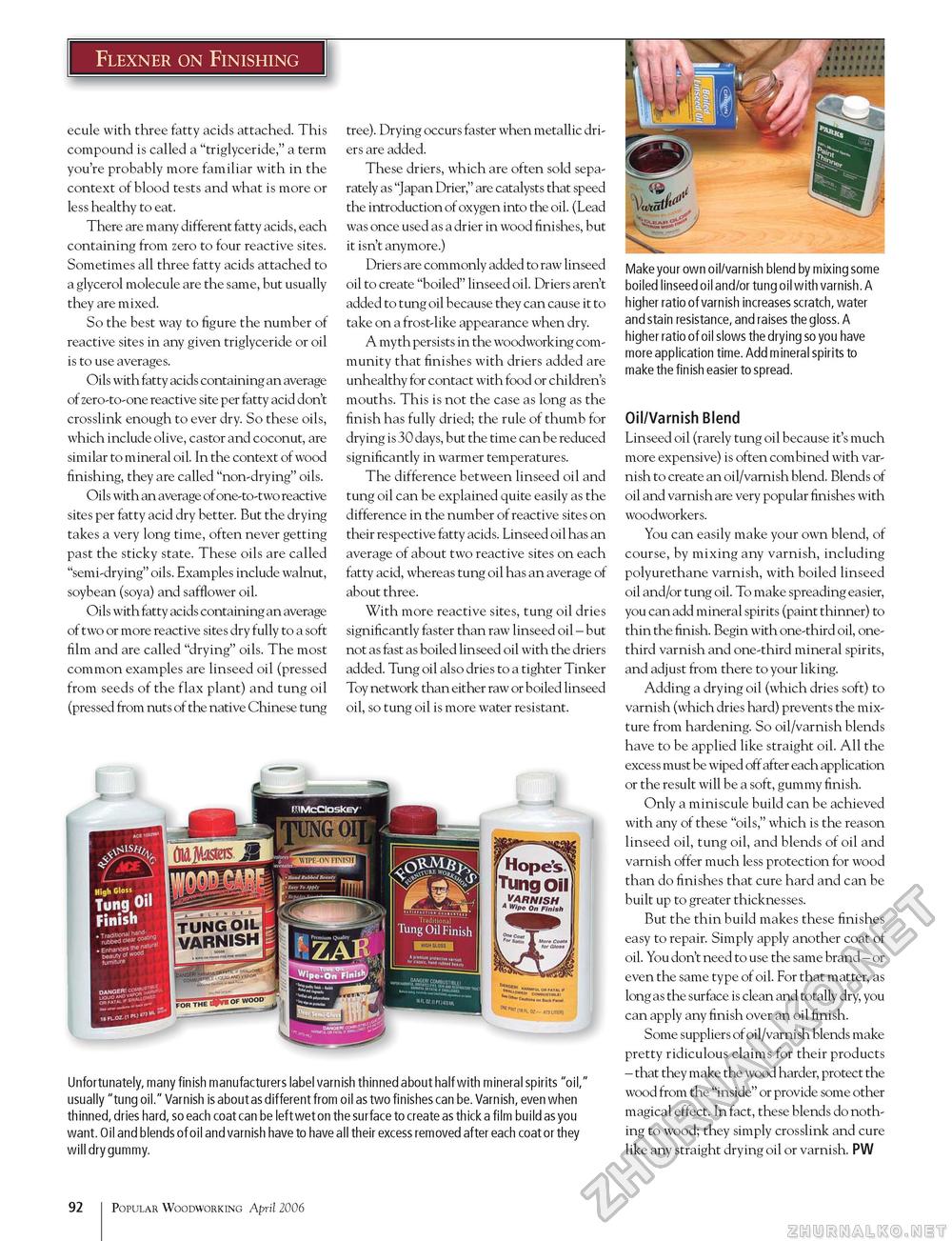Popular Woodworking 2006-04 № 154, страница 95
Flexner on Finishing ecule with three fatty acids attached. This compound is called a "triglyceride," a term you're probably more familiar with in the context of blood tests and what is more or less healthy to eat. There are many different fatty acids, each containing from zero to four reactive sites. Sometimes all three fatty acids attached to a glycerol molecule are the same, but usually they are mixed. So the best way to figure the number of reactive sites in any given triglyceride or oil is to use averages. Oils with fatty acids containing an average of zero-to-one reactive site per fatty acid don't crosslink enough to ever dry. So these oils, which include olive, castor and coconut, are similar to mineral oil. In the context of wood finishing, they are called "non-drying" oils. Oils with an average of one-to-two reactive sites per fatty acid dry better. But the drying takes a very long time, often never getting past the sticky state. These oils are called "semi-drying" oils. Examples include walnut, soybean (soya) and safflower oil. Oils with fatty acids containing an average of two or more reactive sites dry fully to a soft film and are called "drying" oils. The most common examples are linseed oil (pressed from seeds of the flax plant) and tung oil (pressed from nuts of the native Chinese tung tree). Drying occurs faster when metallic driers are added. These driers, which are often sold separately as "Japan Drier," are catalysts that speed the introduction of oxygen into the oil. (Lead was once used as a drier in wood finishes, but it isn't anymore.) Driers are commonly added to raw linseed oil to create "boiled" linseed oil. Driers aren't added to tung oil because they can cause it to take on a frost-like appearance when dry. A myth persists in the woodworking community that finishes with driers added are unhealthy for contact with food or children's mouths. This is not the case as long as the finish has fully dried; the rule of thumb for drying is 30 days, but the time can be reduced significantly in warmer temperatures. The difference between linseed oil and tung oil can be explained quite easily as the difference in the number of reactive sites on their respective fatty acids. Linseed oil has an average of about two reactive sites on each fatty acid, whereas tung oil has an average of about three. With more reactive sites, tung oil dries significantly faster than raw linseed oil - but not as fast as boiled linseed oil with the driers added. Tung oil also dries to a tighter Tinker Toy network than either raw or boiled linseed oil, so tung oil is more water resistant. Unfortunately, many finish manufacturers label varnish thinned about half with mineral spirits "oil," usually "tung oil." Varnish is about as different from oil as two finishes can be. Varnish, even when thinned, dries hard, so each coat can be left wet on the surface to create as thick a film build as you want. Oil and blends of oil and varnish have to have all their excess removed after each coat or they will dry gummy. Make your own oil/varnish blend by mixing some boiled linseed oil and/or tung oil with varnish. A higher ratio of varnish increases scratch, water and stain resistance, and raises the gloss. A higher ratio of oil slows the drying so you have more application time. Add mineral spirits to make the finish easier to spread. Oil/Varnish Blend Linseed oil (rarely tung oil because it's much more expensive) is often combined with varnish to create an oil/varnish blend. Blends of oil and varnish are very popular finishes with woodworkers. You can easily make your own blend, of course, by mixing any varnish, including polyurethane varnish, with boiled linseed oil and/or tung oil. To make spreading easier, you can add mineral spirits (paint thinner) to thin the finish. Begin with one-third oil, one-third varnish and one-third mineral spirits, and adjust from there to your liking. Adding a drying oil (which dries soft) to varnish (which dries hard) prevents the mixture from hardening. So oil/varnish blends have to be applied like straight oil. All the excess must be wiped off after each application or the result will be a soft, gummy finish. Only a miniscule build can be achieved with any of these "oils," which is the reason linseed oil, tung oil, and blends of oil and varnish offer much less protection for wood than do finishes that cure hard and can be built up to greater thicknesses. But the thin build makes these finishes easy to repair. Simply apply another coat of oil. You don't need to use the same brand - or even the same type of oil. For that matter, as long as the surface is clean and totally dry, you can apply any finish over an oil finish. Some suppliers of oil/varnish blends make pretty ridiculous claims for their products - that they make the wood harder, protect the wood from the "inside" or provide some other magical effect. In fact, these blends do nothing to wood; they simply crosslink and cure like any straight drying oil or varnish. PW 92 Popular Woodworking April 2006 |








